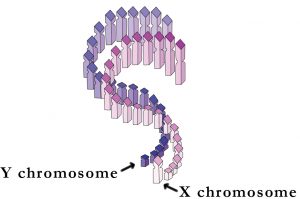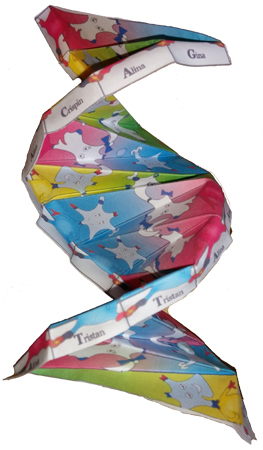If you read the last post, you will be happy in the knowledge that Alina and Tristan are best friends. Gina and Crispin are even better friends and have a stronger bond. They spend most of their time lying around opposite each other in a long and bendy line known as a double helix.

As each of these characters represents a nucleotide base, each pair is known as a base pair.
If all 3 billion of them in the Human Genome were placed end to end, they would be approximately 2 metres long. That would be quite a size for a titchy tiny cell to accommodate. But the Dinky Amigos live in just one part of the cell. This is called the nucleus (unless they are in bacteria where they are free to roam). Stuffing two metres of anything into one part of a cell that is measured in micrometeres (thousandths of a metre) is going to be a lot trickier than getting that final pair of shoes in and sitting on your case at the airport.
As with packing your case, though, the secret is rolling. The Genome is rolled together with proteins called histones. It is then supercoiled to make tight coils. Very tight coils. Absolutely perfect for squeezing everything into a tight space. 
Not quite so perfect when you want to use it, however. Just as it is rather a bind to unpack your entire suitcase at the airport to find your passport (the clever traveller will have stowed it in a slightly more accessible place), so the Dinky Amigos are split into several groups for ease of access.
These groups are called Chromosomes and you will have two sets of 23 (one set from your mother, and one from your father). Twenty-two of these chromosomes (known as autosomes) are responsible for you and most of your body. These chromosomes are numbered 1-22, descending in size as the number increases. The final chromosome is responsible for determining your gender.

These are known as sex chromosomes and come in two variants. An X chromosome determines female and a Y chromosome male gender traits. Each set only contains one of these options. Your mother will pass on 22 autosomal chromosomes and one X chromosome. Your father will pass on 22 autosomal chromosomes and either one X or one Y chromosome (but not both). The presence of a Y chromosome indicates the resulting child will be male.
So far so good, but apart from a master class in packing and a reason to have two separate types of toilet, there doesn’t seem to be a great benefit to us as yet. But never fear – your DNA is here! Next time we will look at how the genome is further sub-divided and how these divisions play a large part in our lives.

